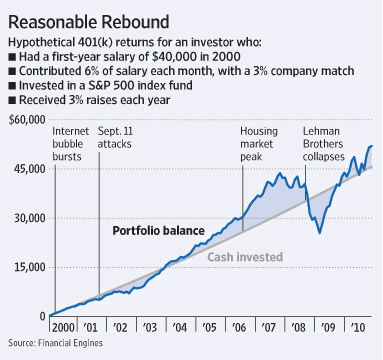You may or may not believe me, but even though I blog daily about money I only check my investment portfolio balances every few weeks. It’s part of my selective information restriction diet. I found it curious that the S&P 500 is now at ~1350. This reminded me of this earlier WSJ article about how long-term savers actually haven’t done all that poorly over the last decide. Their example is a young worker starting investing in 2000, investing regularly, and taking advantage of the 401(k) match from their employer amongst other stated assumptions:

Since the article was published, the S&P 500 is up nearly another 8%. Of course, if you invested in bonds for that decade you’d be even better off, but seriously who was 100% bonds the entire time. I know I wasn’t, but I was invested in some bonds, so I get some comfort that my personal return is a bit better. I’m relatively at peace with my investments, other than being a bit nervous after seeing the S&P so high without any proof of improved economic stability.
 The Best Credit Card Bonus Offers – 2025
The Best Credit Card Bonus Offers – 2025 Big List of Free Stocks from Brokerage Apps
Big List of Free Stocks from Brokerage Apps Best Interest Rates on Cash - 2025
Best Interest Rates on Cash - 2025 Free Credit Scores x 3 + Free Credit Monitoring
Free Credit Scores x 3 + Free Credit Monitoring Best No Fee 0% APR Balance Transfer Offers
Best No Fee 0% APR Balance Transfer Offers Little-Known Cellular Data Plans That Can Save Big Money
Little-Known Cellular Data Plans That Can Save Big Money How To Haggle Your Cable or Direct TV Bill
How To Haggle Your Cable or Direct TV Bill Big List of Free Consumer Data Reports (Credit, Rent, Work)
Big List of Free Consumer Data Reports (Credit, Rent, Work)
Not so good if you get an annualized return. Some people do put all cash in CDs, and they’ve been winning in the last 10 yrs.
where do I sign up for 3% raises every year? in that decade my work cutout overtime pay and then had 0% raises for several years. Last year was “good” and I got 2.3% while being rated above my peer group.
I suppose it’s reasonable if your business is based on other businesses paying you for 401(k) consulting.
But when you compare it to inflation over the same period:
http://research.stlouisfed.org/fredgraph.png?g=F5
When will 401(k) plans allow investing in physical metals?
I’ve been investing in my 401K since 2002 at approximately 15-22% of my salary every year and I must say that my balance is only still at an approximately total of $85,000.
This is not impressive, I know, after all these years. It may be because most of the money is in domestic and international stock funds. At one point, it was down to $25,000 from the middle $50,000s.
I’m still waiting for the account to make some significant profits from initial investments. While i have faith that it’ll start making more gains than it has been for the last decade, it’s a battle of patience.
I’m not worried about a bubble. Bubbles are the product of inflated expectations. The S&P isn’t growing based on expectations — it’s growing based on profits. Look at the graph I’ve linked to: clearly the runup in the late ’90s into 2000 was a bubble, as it was not supported by growth in profits (remember the “profits will follow!” mantra?). The current rally is real growth.
http://research.stlouisfed.org/fredgraph.png?g=Fr
Haha love that there’s another FRED junkie on here…
I joined the workforce in January of 2000 making that exact salary. I can’t remember how much I was putting in my 401(k) at that time, but after four years or so I left to join a start-up with no retirement plan. I moved that retirement money largely into cash at that point because I figured I had enough risk in my day job and essentially stopped saving for retirement (which I realize was not smart).
After three years I returned to a much more stable employment situation with good benefits and started contributing to the new retirement plan. I also moved my original 401(k) money into a Swensen-like well-diversified portfolio and it was exposed to the global financial crisis and rebound. The bottom line is that original account is now worth around $48k, which is very close to the value of the simulated portfolio in the article.
I have to agree with Scott. Any stats on average annual raises over the past decade? From my reading, wages have been pretty flat across the board for quite some time.
Investment have to be continuous. No matter investing in monthly, quarterly or yearly, we are practicing dollar cost average which is a proven method of getting consisting return in the long run. Beside dollar cost averaging, frequent review in our investment portfolio is a must especially in asset allocation. This is to diversify our investment risks and to maximize our return in the long run.